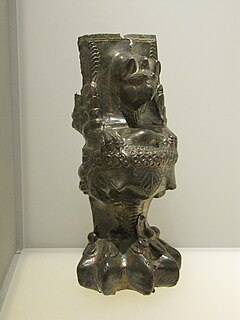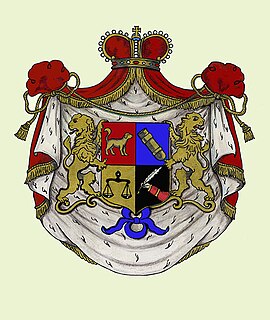Related Research Articles

Pharnavaz I was a king of Kartli, an ancient Georgian kingdom known as Iberia in classical antiquity. The Georgian Chronicles credits him with being the first monarch founding the kingship of Kartli and the Pharnavazid dynasty, while other independent chronicles, such as The Conversion of Kartli make him the second Georgian monarch. Based on the medieval evidence, most scholars locate Pharnavaz's rule in the 3rd century BC: 302–237 BC according to Prince Vakhushti of Kartli, 299–234 BC according to Cyril Toumanoff and 284–219 BC according to Pavle Ingoroqva. Pharnavaz's rise, advent and imperial expansion of the Iberian monarchy was directly tied to the victory of Alexander the Great over the Achaemenid Empire. Pharnavaz ruled under the suzerainty of the Seleucid Empire.

The Georgians, or Kartvelians, are a nation and indigenous Caucasian ethnic group native to Georgia and the South Caucasus. Large Georgian communities are also present throughout Russia, Turkey, Greece, Iran, Ukraine, the United States and European Union.

Mirian III was a king of Iberia or Kartli (Georgia), contemporaneous to the Roman emperor Constantine the Great. He was the founder of the royal Chosroid dynasty.

Kartli is a historical region in central-to-eastern Georgia traversed by the river Mtkvari (Kura), on which Georgia's capital, Tbilisi, is situated. Known to the Classical authors as Iberia, Kartli played a crucial role in the ethnic and political consolidation of the Georgians in the Middle Ages. Kartli had no strictly defined boundaries and they significantly fluctuated in the course of history. After the partition of the kingdom of Georgia in the 15th century, Kartli became a separate kingdom with its capital at Tbilisi. The historical lands of Kartli are currently divided among several administrative regions of Georgia.
Saurmag was a monarch of Kartli listed as the second king in the traditional royal list of medieval Georgian chronicles. Professor Toumanoff suggest the years 234–159 BC as the period of his reign.
Mirian I was king of Iberia from 159 BC to 109 BC. His name (Mihrbān), of Middle Iranian origin, means "friendly, kind", and is derived from Old Iranian Mithrāpāna, meaning "having the protection of Mithra".
Cyril Leo Toumanoff was a Russian-born Georgian historian and genealogist who mostly specialized in the history and genealogies of medieval Georgia, Armenia, Iran and the Byzantine Empire. His works have significantly influenced the Western scholarship of the medieval Caucasus.
Arian Kartli or Aryan-Kartli was a country claimed by the medieval Georgian chronicle "The Conversion of Kartli" to be the earlier homeland of the Georgians of Kartli.

The Pharnavazid is the name of the first dynasty of Georgian kings of Kartli (Iberia) preserved by The Georgian Chronicles. Their rule lasted, with intermissions, from the 3rd century BC to the 2nd century AD. The main male line is reported to have become extinct early on and followed by houses related to it in the female line. By the close of the 2nd century AD, the Pharnavazid rule came to an end and the Arsacid Dynasty took over the crown of Iberia.
Amazasp III or Hamazasp I was a king of Iberia from 260 to 265 AD. According to Cyril Toumanoff he may have been a scion of the Pharnavazid dynasty, while Richard N. Frye states that he was an Iranian, possibly related to the royal Sasanian family.

Adarnase II, of the Chosroid dynasty, was a presiding prince of Iberia from c. 650 to 684/5. He is presumably the Iberian patricius mentioned in the 660s letter of Anastasius Apocrisarius pertaining to the martyrdom of Maximus the Confessor, and the prince Nerses whose revolt against Arabs is reported by the Armenian chronicler Hovannes Draskhanakertsi.

The Tumanishvili or Tumanyan, later Russianized as Toumanov or Toumanoff is an Armeno-Georgian noble (tavadi) family.
Juansher Juansheriani was a Georgian prince (eristavi) and historian, related to the royal Chosroid dynasty of Iberia, whose appanage consisted of the lands in Inner Iberia and in Kakheti.
Adarnase was a late 8th-century nobleman of Iberia and the founder of the Georgian Bagratid dynasty. He established himself in Tao-Klarjeti as a vassal of the Chosroid dynasty of Iberia and, as a matter of inheritance, acquired more lands, setting stage for the elevation of the Bagratids—in the person of his son Ashot I—to the principate of Iberia.
Varsken was an Iranian prince from the Mihranid family of Gugark, who served as the bidaxsh (margrave) of the region from 470 to 482. He was the son and successor of Arshusha II.
Barzabod was a high-ranking Iranian official in 5th-century Sasanian Iran. A Mihranid prince of the Gardman region, he served as the viceroy of Caucasian Albania.
A legend that the Georgian royal Bagrationi dynasty were of a Hebrew origin and descended from David dates back to the family's appearance on the Georgian soil in the latter half of the eight century. As the Bagratid power grew, this claim morphed into an officially endorsed paradigm, enshrined in medieval historical literature such as the early 11th-century chronicle of Sumbat Davitis-dze, and formed the basis of the dynasty's political ideology for the duration of their millennium-long ascendancy in Georgia. The proposed Davidic descent allowed the Bagrationi to claim kinship with Jesus Christ and the Virgin Mary and rest their legitimacy on a biblical archetype of the God-anointed royalty.

The Stele of Vespasian is a stele with Ancient Greek inscriptions found in 1867 at Armazi, near Mtskheta, Georgia in the ancient capital of the Kingdom of Iberia. The stele memorialises reinforcement of fortification of Armazi walls by Emperor Vespasian. Additionally, the inscription mentions two emperors Titus, Domitian and two kings Mihrdat I of Iberia, Pharasmanes I of Iberia and prince royal Amazaspus. The inscription is dated 75 AD. The top of the stele is lost. According to Professor David Braund the missing text was in Latin or Armazic. Cyril Toumanoff identifies Amazaspus as King Amazasp I of Iberia, though it can be prince royal Amazaspus, son of Pharasmanes I of Iberia, who is known from the Epigram of Amazaspos found in Rome.
Bidaxsh was a title of Iranian origin attested in various languages from the 1st to the 8th-century. It has no identical word in English, but it is similar to a margrave, toparch and marcher lord. The etymology of the term is disputed, and it has been interpreted as literally meaning "the eye of the king," "second ruler" or "vice king." The word was borrowed into Armenian as Bdeašx (բդեաշխ), and into Georgian as Pitiaxshi (პიტიახში) and Patiaxshi (პატიახში).
The Mihranids of Gugark were an Iranian princely dynasty, which ruled the Armeno-Iberian frontier region of Gugark from c. 330 to the 8th-century. They held the title of bidaxsh ("margrave").
References
- ↑ Toumanoff 1963, p. 262.
- ↑ Rapp 2014, p. 389.